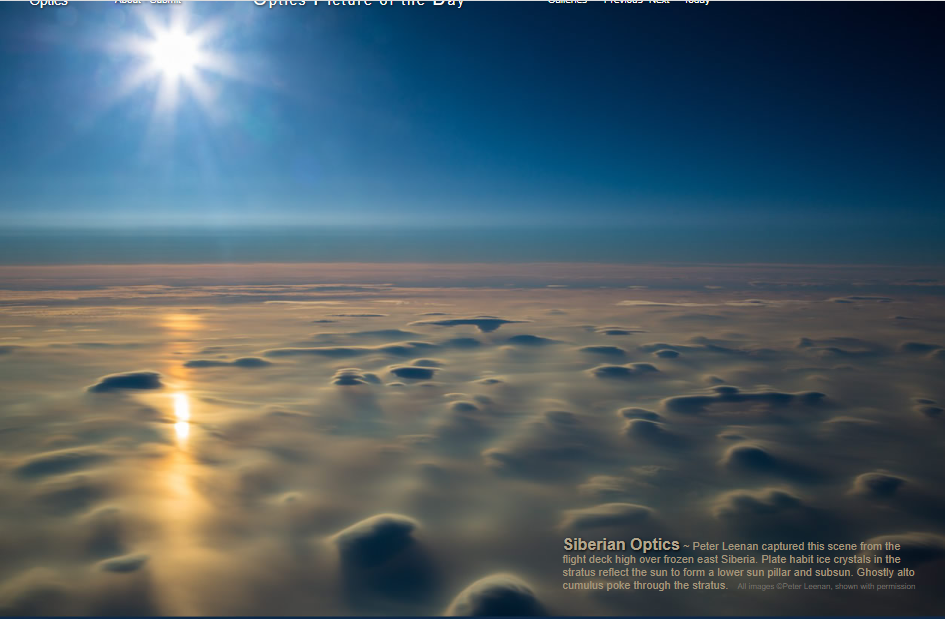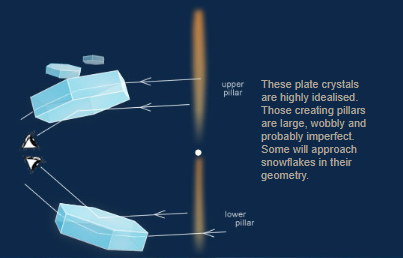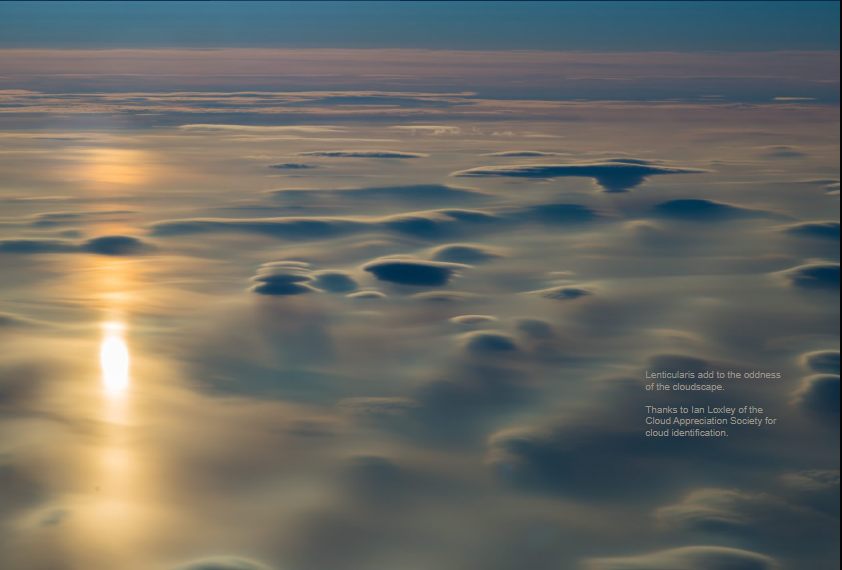Lower Pillar & Subsun, Siberia - OPOD
Lower Pillar & Subsun: A Captivating Atmospheric Phenomenon in Siberia
Siberia, known for its extreme climate and breathtaking landscapes, also offers a captivating display of atmospheric optics. One such phenomenon is the lower sun pillar and subsun, beautifully captured by Peter Leenan from the flight deck high above frozen east Siberia. These mesmerizing images showcase the interplay of plate habit ice crystals in the stratus clouds, reflecting the sun's rays to form a lower sun pillar and subsun. Additionally, ghostly alto cumulus clouds can be seen piercing through the stratus, adding to the ethereal beauty of the scene.
The Intricate Formation of Pillars & Subsuns
The pillars and subsuns observed in Siberia are both formed through the reflection of sunlight by plate crystals. These plate crystals, although highly idealized in the images, are actually large, wobbly, and often imperfect. Some of these crystals may even resemble snowflakes in their geometry. It is the collective presence of countless plate crystals that creates a stunning mirror-like effect.
Pillars are formed when the plate crystals wobble from their horizontal orientation. This slight deviation from perfect alignment causes the sunlight to scatter and create a pillar-like structure. On the other hand, subsuns occur when the plate crystals align themselves horizontally with remarkable precision. As a result, the reflected sunlight appears as a bright spot just below the sun. Interestingly, it is not uncommon to witness both pillars and subsuns simultaneously, as demonstrated in the Siberian photographs.
The Delicate Beauty of Stratus Clouds
In Peter Leenan's photographs, the thin stratus clouds provide a mesmerizing canvas for the lower sun pillar and subsun. These clouds appear as a uniform layer, allowing the sunlight to penetrate through and interact with the plate crystals suspended within. In some areas, the ground becomes visible through breaks in the stratus, creating a captivating interplay between the cloud cover and the landscape below. Care must be taken not to mistake reflections from rivers or lakes for subsuns. By observing how the intensity of the reflection varies as it crosses the cloud and landscape, one can distinguish between the two.
The Enigmatic Lenticularis Clouds
Adding to the intrigue of the Siberian cloudscape are lenticularis clouds, also known as lenticular clouds. These lens-shaped clouds often form in the presence of strong winds or when moist air encounters obstacles, such as mountains. Their unique shape and smooth, well-defined edges make them a fascinating sight. In Peter Leenan's photographs, these lenticularis clouds contribute to the overall oddness and allure of the atmospheric display.
Appreciating the Wonders of Atmospheric Optics
The captivating images captured by Peter Leenan serve as a reminder of the awe-inspiring wonders that occur in our atmosphere. From the delicate formation of plate crystals to the interplay between sunlight and clouds, atmospheric optics never fails to amaze. Thanks to dedicated individuals like Ian Loxley of the Cloud Appreciation Society, who help identify and understand these phenomena, we can deepen our appreciation for the natural beauty that surrounds us.
In conclusion, the lower sun pillar and subsun observed in Siberia exemplify the mesmerizing interplay between sunlight and plate crystals within the stratus clouds. The formation of pillars and subsuns occurs through the reflection of sunlight by plate crystals, resulting in stunning visual displays. The delicate beauty of the thin stratus clouds and the enigmatic presence of lenticularis clouds add to the allure of this atmospheric phenomenon. By taking the time to appreciate and understand atmospheric optics, we gain a deeper appreciation for the intricate wonders that unfold above us.

Siberian Optics ~ Peter Leenan captured this scene from the flight deck high over frozen east Siberia. Plate habit ice crystals in the stratus reflect the sun to form a lower sun pillar and subsun. Ghostly alto cumulus poke through the stratus. All images ©Peter Leenan, shown with permission

These plate crystals are highly idealised. Those creating pillars are large, wobbly and probably imperfect. Some will approach snowflakes in their geometry.
Pillars & Subsuns
Both are formed by reflection from plate crystals. The reflection can be external or internal from the opposite large hexagonal face. In effect, the cloud of untold millions of crystals acts as a huge mirror.
Pillars form when the crystals wobble from horizontal. Subsuns are from crystals aligned horizontal rather precisely. As here, both types can be present at once.

This image show the thin stratus with the ground showing though in places. Care is needed not to mistake a river or lake reflection for a subsun. Check how it varies in intensity as crosses the cloud/landscape.
The circle is an artifact from the flight-deck window.

Lenticularis add to the oddness of the cloudscape.
Thanks to Ian Loxley of the Cloud Appreciation Society for cloud identification.
Note: this article has been automatically converted from the old site and may not appear as intended. You can find the original article here.
Reference Atmospheric Optics
If you use any of the definitions, information, or data presented on Atmospheric Optics, please copy the link or reference below to properly credit us as the reference source. Thank you!
-
<a href="https://atoptics.co.uk/blog/lower-pillar-subsun-siberia-opod/">Lower Pillar & Subsun, Siberia - OPOD</a>
-
"Lower Pillar & Subsun, Siberia - OPOD". Atmospheric Optics. Accessed on November 26, 2024. https://atoptics.co.uk/blog/lower-pillar-subsun-siberia-opod/.
-
"Lower Pillar & Subsun, Siberia - OPOD". Atmospheric Optics, https://atoptics.co.uk/blog/lower-pillar-subsun-siberia-opod/. Accessed 26 November, 2024
-
Lower Pillar & Subsun, Siberia - OPOD. Atmospheric Optics. Retrieved from https://atoptics.co.uk/blog/lower-pillar-subsun-siberia-opod/.